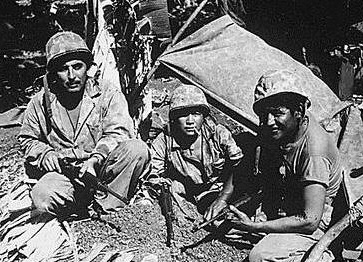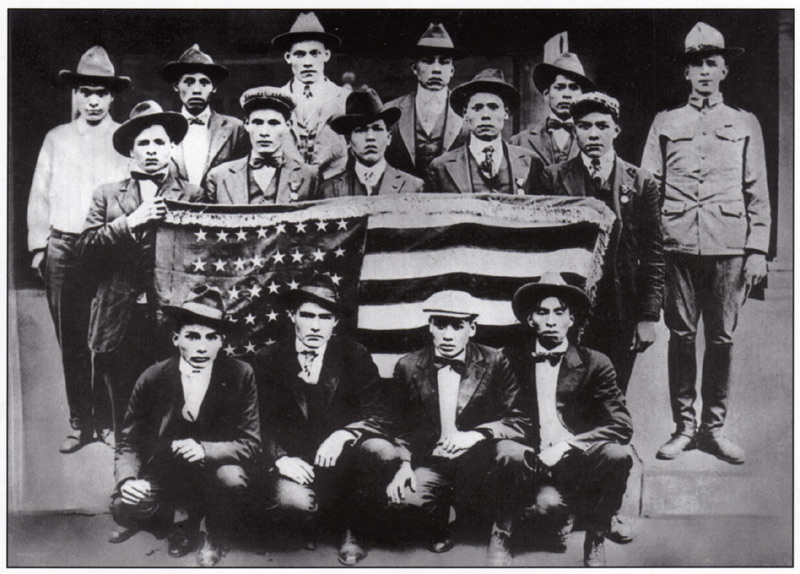Native American Code Talkers
 Did you know that Native Americans used their native languages during World War I and World War II to help keep American troop movements secret?
Did you know that Native Americans used their native languages during World War I and World War II to help keep American troop movements secret?
Native Americans have a long and storied service as American military personnel. They served in many wars over the years with honor despite facing trials and discrimination at home. In the 20th century, their contributions to military code and intelligence were recognized in World War I and again in World War II.
Aptly named “code talkers,” they were employed by the United States military during both World Wars to use their native, lesser-known languages as a means to communicate secretly using coded messages. At the highest point, during World War II, there were between 400-500 Native Americans in and working alongside the United States Marine Corps with the primary task of transmitting secret tactical messages on movements, enemy position, etc. Codes were transmitted over military telephone or radio communications through developed codes built upon these heroes’ native languages.
 During World War I, a number of Native Americans served in the United States Signal Corps as code talkers passing coded messages in their native languages including Choctaw, Cherokee, and others. Members of the Choctaw Nation of Oklahoma helped relay messages to other American troops stationed across Europe, pioneering the practice of using Native American languages as military code. For those interested, you can learn more about their importance and impact in World War I by reading The First Code Talkers: Native American Communicators in World War I, available for loan from the Museum & Library.
During World War I, a number of Native Americans served in the United States Signal Corps as code talkers passing coded messages in their native languages including Choctaw, Cherokee, and others. Members of the Choctaw Nation of Oklahoma helped relay messages to other American troops stationed across Europe, pioneering the practice of using Native American languages as military code. For those interested, you can learn more about their importance and impact in World War I by reading The First Code Talkers: Native American Communicators in World War I, available for loan from the Museum & Library.
Over 400 Navajo served in the Marine Corps as code talkers over the course of WWII, primarily in the war's Pacific Theater. Two types of code were utilized during World War II, both were based on a combination of languages from the Comanche, Hopi, Meskwaki, and Navajo peoples. The original 29 of the 400+ Navajo that were enlisted for efforts in WWII were eventually awarded the Congressional Gold Medal in 2000-2001. Then in 2008, additional code talkers from the Choctaw and Navajo tribes, along with other Native American tribes, were recognized with the Congressional Gold Medal for their service during World War I and II.
To Learn More, Read:
Aaseng, Nathan. Navajo Code Talkers. New York: Walker, 1992.
Britten, Thomas A. American Indians in World War I: At Home and at War. Albuquerque: University of New Mexico Press, 1999.
Harris, Alexandra N, Mark G Hirsch, National Museum of the American Indian (U.S.), and Smithsonian Institution. Why We Serve: Native Americans in the United States Armed Forces. First ed. Washington, DC: National Museum of the American Indian, Smithsonian Institution, 2020.
Hauptman, Laurence M. The Iroquois in the Civil War: From Battlefield to Reservation. 1st ed. The Iroquois and Their Neighbors. Syracuse, N.Y.: Syracuse University Press, 1993.
Knudson, Michael, and Ann. G Knudson. Warriors in Khaki: Native American Doughboys from North Dakota. United States: Robertson Publishing, 2012.
Meadows, William C. The First Code Talkers: Native American Communicators in World War I. The Civilization of the American Indian Series, Volume 281. Norman: University of Oklahoma Press, 2021.
Viola, Herman J. Warriors in Uniform: The Legacy of American Indian Heroism. Washington, D.C.: National Geographic, 2008.
Recommendations for Younger Readers:
Buckley, James, and Gregory Copeland. Who Were the Navajo Code Talkers? Who Were. New York: Penguin Workshop, 2022.
Hoena, B. A, and Pérez Massegú Marcel. Navajo Code Talkers: Top Secret Messengers of World War II. Graphic Library. Amazing World War II Stories. North Mankato, Minnesota: Capstone Press, a capstone imprint, 2020.